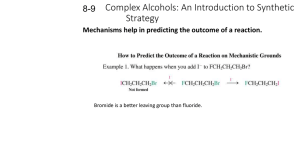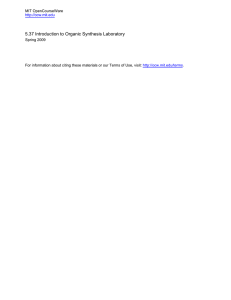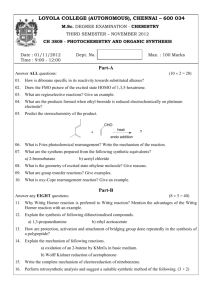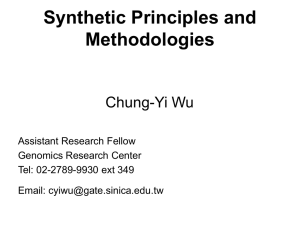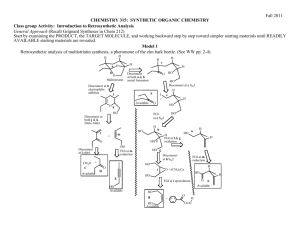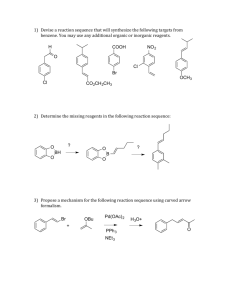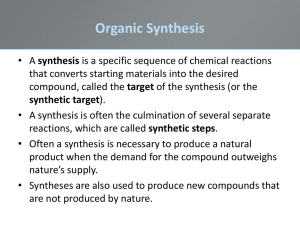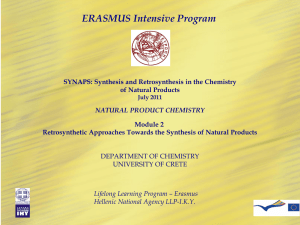Lecture 1
advertisement
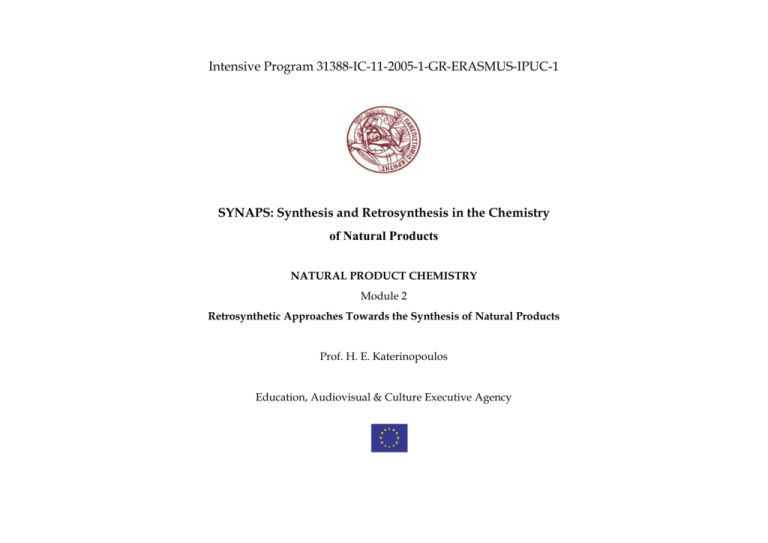
Intensive Program 31388-IC-11-2005-1-GR-ERASMUS-IPUC-1 SYNAPS: Synthesis and Retrosynthesis in the Chemistry of Natural Products NATURAL PRODUCT CHEMISTRY Module 2 Retrosynthetic Approaches Towards the Synthesis of Natural Products Prof. H. E. Katerinopoulos Education, Audiovisual & Culture Executive Agency INTRODUCTION Based on: S. Warren Organic Synthesis: The Disconnection Approach, Wiley: New York, 1982 • • • • • • • • • • • Chemists synthesize compounds in just about every organic chemistry laboratory in the world. Industrial chemists synthesize pharmaceuticals, polymers (plastics), pesticides, dye stuffs, food colorings and flavorings, perfumes, detergents and disinfectants. Research chemists synthesize natural products whose structure is uncertain, compounds for mechanistic investigations, possible intermediate in chemical and biological processes, thousands of potential drugs for everyone which is used in medical practice, and even compounds which might themselves be useful for organic syntheses. Before and during these syntheses, groups of chemists sitting around blackboards or piles of paper plan the work they are about to undertake. Possible routes are drawn out, criticized, modified again when the behavior of the compounds in the flask turns out to be different from what was expected, until finally success is achieved. The aim of this lecture is to show how this planning is done: to help you learn the disconnection or synthon approach to organic synthesis. This approach is analytical: we start with the molecule we want to make (the target molecule) and break it down by a series of disconnection into possible starting materials. Classifications in Synthetic Methodology Based on “Lecture Notes, Modern Organic Synthesis” by Dale L. Boger at The Scripps Research Institute, TSRI Press, La Jolla, CA, 1999 Classifications in Synthetic Methodology Classifications in Synthetic Methodology Retrosynthesis or Retrosynthetic Analysis ROUTINE FOR DESIGNING A SYNTHESIS • ANALYSIS • 1. 2. 3. 4. Define the target molecule Recognize the functional groups in the target molecule Disconnect using as a guide methods corresponding to known reactions Repeat the Retrosynthetic Analysis till you reach available starting materials • SYNTHESIS 1. Write down a synthetic scheme based in the Retrosynthetic Analysis adding reagents and reaction conditions. 2. If the synthesis fails, modify the synthetic scheme based on the failures/successes in the laboratory experiments. SYNTHONS AND REAGENTS • During the retrosynthetic analysis of compound 2 the retrosynthetic cleavage (or disconnection) leads to a nucleophile(-) and an electrophile (+). The correct alternative, based in known chemical transformations, is in this case leading to 3 and 4. O O a MeO MeO 4 3 b O MeO After the right choice has been made, the synthons may be converted retrosynthetically in to the corresponding reagents. H O MeO MeO O MeO SYNTHONS O Cl REAGENTS ONE GROUP DISCONNECTIONS Based on: S. Warren Organic Synthesis: The Disconnection Approach, Wiley: New York, 1982 1.1 Carbonyl derivatives R(C=O)X Derived from the corresponding carboxylic acids or their derivatives. O O O O > R > R Cl O O R' > R OR' R NR' 2 Example: Retrosynthesis of Popanil, a weed killer used in the rice fields: O NH2 HN O FG + Cl Cl Cl Cl Synthesis: Cl
